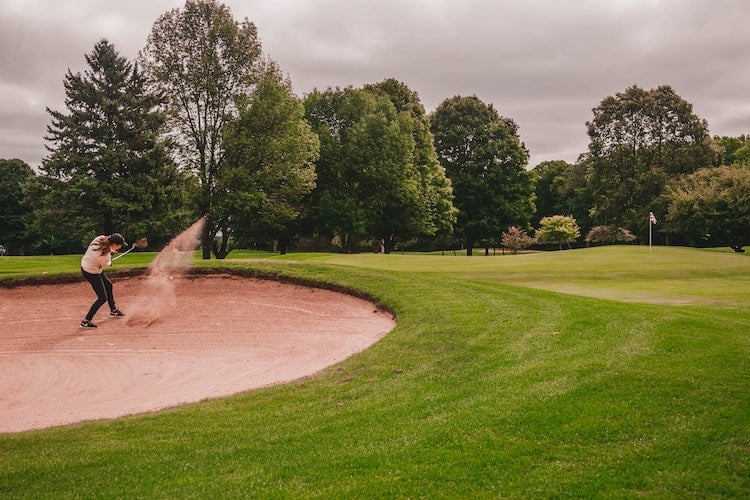Regripping Golf Clubs: How Soon Can You Play?
It is recommended to wait at least 24 hours after regripping a golf club before using it again. The adhesive and grip need time to set properly.
After regripping a golf club, it is important to allow the adhesive and grip to set properly before using it again. Typically, it is recommended to wait at least 24 hours before taking your new and improved club out with you to the golf course.
Waiting ensures that your grip will not twist or slip while you play, which can ultimately alter your performance. While waiting may seem frustrating, it is crucial to ensure that your golf club is in the best condition possible for your next game. Additionally, waiting allows you to take the time to properly adjust and get used to your new grip before you hit the green again.

The Importance Of Regripping And What It Entails
Regripping golf clubs is an essential process for any professional or amateur golfer who wants to maintain their equipment and level of performance. Keeping the grips on your golf clubs in excellent condition is crucial to ensure a precise grip, control over your shot, and confidence on the course.
Understanding The Significance Of Regripping
Replacing the grips on golf clubs is called regripping, and it should be performed at least once a year, depending on how often you play and the quality of the grips. The significance of regripping can be defined into three main points:
- Maintain the performance level of the clubs: Golf grips are subjected to wear, weather, and other elements that deteriorate their original condition over time. Regripping ensures that every club in your bag is up to the task and would deliver the performance expected.
- Prevent injuries and mishaps while playing: Worn-out or damaged grips can lead to slipping incidents, which can result in injuries and affect your golf game. Regripping may solve this problem and eliminate any slipping-related issues.
- Maintain hygiene: Sweat, dirt, and oil from your hands get absorbed into the grips, creating a breeding ground for bacteria and germs. Regripping the golf clubs guarantees a clean start and removes any potential health hazards.
Explaining The Grip Wear And Tear
Golf grips experience numerous types of wear and tear, which can affect how they perform. Here are some of the most common reasons why you should consider regripping your clubs:
- Sweating: Sweat is corrosive and gradually eats away the grip material. Additionally, the salt present in sweat can dry out the grip, making it less pliable.
- Ultraviolet rays: Exposure to uv rays can make golf grips brittle and firm, losing their gripping power and comfort.
- Moisture and humidity: Golf grips exposed to moisture can start to rot, leading to a reduction in the grip’s quality.
- General wear and tear: Repeated use causes the grips to become compressed and slick, reducing the amount of traction between the grip and your hands.
The Importance Of Regripping Clubs
Regripping clubs is an essential practice for golfers of all levels. Here are some good reasons to regrip your clubs:
- Improve performance: A worn-out or damaged grip makes it challenging to control the club and deliver the intended shot accurately. Replacing the grip can result in better performance and a more comfortable grip.
- Save money: Regripping can save money compared to purchasing brand-new clubs. It is, therefore, a more cost-effective way to ensure your equipment is in top condition.
- Ensure safety while playing: Regripping can eliminate the risk of slipping and ensure that your club remains tightly gripped by your hands.
- Customization: Regripping provides a chance to customize your club’s grip to your specific preferences.
Now that you understand the importance of regripping golf clubs, you should seek a professional opinion on when to replace your grips and choose the right grip for your playing style. Remember, regripping ensures that your golf clubs remain in optimal condition and contributes to improving your overall game.
When Is It The Right Time To Regrip Golf Clubs?
Golf clubs, like any other sports equipment, undergo wear and tear. Over time and with consistent use, the grip on golf clubs can wear out, affecting your game. If you’re wondering when to regrip golf clubs, you’ve come to the right place.
We’ll identify the signs to look out for grip wear and tear, discuss the frequency of regripping based on usage and maintenance, and talk about the ideal time to regrip golf clubs.
Identifying The Signs To Look Out For Grip Wear And Tear
The grip on a golf club has a significant impact on the feel of the club and, more importantly, your performance on the course. The following signs may indicate that regripping is necessary:
- Smooth or slippery surface on the grip
- Cracks or cuts in the grip
- Wear on the top of the grip
- Visible damage or wear to the grip
Keep an eye out for these signs, and if the grip shows any of these signs, or if they feel loose, then it’s time to regrip.
Frequency Of Regripping Based On Usage And Maintenance
The frequency of regripping depends on several factors, including how often you play, your grip pressure, and how well you take care of the grips. Here are some guidelines:
- Frequent golfers who play multiple times a week should consider regripping every six months.
- Golfers who play once or twice a week should regrip their clubs once a year.
- Golfers who do not use their clubs regularly may be able to wait longer before regripping, but it’s best to check for wear or damage before playing.
Proper maintenance of the grip can extend its life, including regular cleaning and avoiding exposure to extreme temperatures or moisture.
The Ideal Time To Regrip Golf Clubs
Regripping golf clubs can be done at any time of the year. However, the best time to regrip is during the offseason or winter months when golfing activity is low. That way, your clubs will be ready for the upcoming season, and you won’t have to worry about grip wear during the peak golfing months.
It’s essential to pay attention to the wear and tear on your golf clubs’ grips. Identifying the signs, frequency of regripping based on usage and maintenance, and the ideal time to regrip golf clubs are all important steps in keeping your equipment in good condition.
Ensure your playing comfort and optimal performance by regripping your clubs as necessary.
The Processes Involved In Regripping Golf Clubs
Regripping your golf clubs is essential for maintaining a good grip and preventing slippage during swings. However, it’s vital to know how long to wait after regripping before using your clubs. In this section of the blog, we will discuss the processes involved in regripping and how to ensure your clubs are safe to use.
The Materials Required For Regripping
Before beginning the regripping process, you’ll need to gather necessary materials. Ensure that you have the following:
- New golf grips
- Double-sided grip tape
- Grip solvent
- A vice or clamp
- A hook blade or grip knife
- A bucket or tray
- A clean rag
The Steps To Take Before Regripping
Before regripping your clubs, it’s essential to take the necessary steps to prepare them for the process. Here are a few steps to follow:
- Remove any rings or other jewelry that can cause damage to the new grips
- Clean your clubs thoroughly to get rid of any dirt or debris
- Check your existing grips for any signs of damage and remove any damaged grips
- Dry your clubs using a clean rag
How To Remove Old Grips And Apply New Ones
Once you’ve gathered your materials and taken the necessary steps, you can begin removing old grips and applying new ones. Follow these steps:
- Secure the club in a vice or clamp before starting the regripping process.
- Cut the old grip off using a hook blade or grip knife. Be careful not to damage the shaft while cutting the grip.
- Remove any remaining tape from the shaft with grip solvent and a clean rag.
- Apply double-sided tape to the shaft in even layers, avoiding any wrinkles.
- Apply a generous amount of grip solvent to the tape, ensuring it’s evenly spread.
- Slide the new grip onto the shaft, ensuring it’s aligned correctly.
- Wipe off any excess solvent from the club and allow it to dry.
Curing Time And Precautions After Regripping
After regripping, it’s essential to take certain precautions and give enough curing time before using your clubs. Here are a few important tips:
- Allow at least 24 hours for the grip solvent to cure before using your clubs. This ensures the grip is secure and won’t slip during swings.
- Store your clubs at room temperature and avoid storing them in extreme heat or cold.
- When using your newly regripped clubs for the first time, hit a few test shots to ensure everything is in order before playing your usual round.
With these tips, you’re ready to regrip your golf clubs and be assured of its performance. Happy playing!
Can You Play Immediately After Regripping?
Regripping is an important aspect of playing golf. Not only does it allow for a better grip, but it also ensures that your clubs perform at an optimal level. However, the question arises, can you play with your golf clubs immediately after regripping?
It’s a common query that many golfers have, and in this blog post, we’ll answer it. In addition, we’ll look at the factors that determine playability after regripping, the ideal time to wait before playing, and techniques for playing immediately after regripping.
Factors That Determine Playability After Regripping
The gripping process modifies the diameter of the golf club’s shaft. As a result, the club’s swing weight may alter. Factors that affect the playability of a golf club after regripping include:
- The type of grip: Some grips require more time to set than others. A grip with adhesive backing requires a longer wait time before playing, while a water-based grip can be played with almost immediately.
- Humidity and temperature: The curing time of adhesive-backed grips can be increased in high humidity and low-temperature conditions.
- Type of solvent: The type of solvent used in the gripping process could impact how long it takes for the grip to be playable.
The Ideal Time To Wait Before Playing
The ideal time to wait before playing after regripping is subjective and depends on the type of grip that you use. Generally, adhesive-backed grips require 24 hours of curing before use, while air-cushioned grips can be played with immediately. If you want to be safe, it’s best to wait 24 hours before playing with your regripped clubs.
Techniques For Playing Immediately After Regripping
If you can’t wait for the adhesive to cure and want to play immediately after regripping, here are some techniques you can use:
- Wear gloves: Wearing gloves can counteract the diminished grip caused by the uncured adhesive.
- Use a towel: A towel can help in maintaining a firm grip and prevent slippage.
- Grip the club harder: Gripping the club harder than usual can also help in counteracting the decreased performance caused by the uncured adhesive.
Regripping is an essential part of playing golf. However, you should wait before using your regripped clubs. While it may be tempting to play immediately, waiting for 24 hours will ensure that the adhesive bond is strong and that your clubs perform at an optimal level.
If you’re in a hurry and can’t wait, using gloves, towels, and a firm grip can help you play immediately after regripping.
Tips For Properly Maintaining Regripped Golf Clubs
Regripping your golf clubs can make all the difference in your game. However, it’s important to know how to properly maintain them to ensure they last. Here are some tips for maintaining regripped golf clubs that you will find helpful if you want your clubs to perform at their best.
Cleaning And Storing Regripped Clubs
Cleaning and proper storage is crucial to maintaining your regripped golf clubs. Here are some essential tips:
- After each game, clean the clubs with a soft brush and soapy water, then dry them thoroughly.
- Wipe down the grips with a damp cloth to remove any dirt or debris. Never use any harsh chemicals or solvents to clean the grips.
- Store your clubs in a dry area that is not exposed to extreme temperatures or sunlight. Keep them out of reach of children or pets.
- Cover your clubs with headcovers to protect them from scratches or other damage.
The Impact Of Environmental Factors On Regripped Clubs
Environmental factors can impact the quality of your regripped golf clubs. Here are some factors to consider:
- Exposure to heat or sunlight can cause grips to become hard and slick.
- Moisture or prolonged exposure to water can cause grips to become slippery and difficult to grip.
- Extreme temperature changes can cause grips to expand or contract, affecting their overall performance.
Techniques For Prolonging The Quality Of Regripped Clubs
Proper maintenance can help prolong the life of your regripped golf clubs. Here are some techniques you can use:
- Rotate your clubs to ensure that each club is used equally, preventing excessive wear and tear on a single club.
- Use gloves to protect your grips from oils and sweat, which can cause them to become slippery.
- Replace your grips every 40-60 rounds or when they become worn or slick.
- Work with a local golf shop or professional to have your clubs inspected regularly to ensure they are performing at their best.
By following these simple tips, you can help ensure that your regripped golf clubs perform at their best, helping you achieve a better game and enjoy your time on the course even more.
Frequently Asked Questions For How Long To Wait After Regripping Golf Clubs
How Often Should You Regrip Golf Clubs?
Experts recommend every 40 rounds or annually. Worn grips affect grip pressure, leading to inconsistent swings.
Can You Play Golf Immediately After Regripping?
It’s best to wait at least 4 hours to allow the adhesive to set for proper adherence.
Is It Okay To Regrip Golf Clubs Yourself?
Yes, regripping golf clubs is an easy process that can be done at home with proper tools and instruction.
Conclusion
Knowing how long to wait after regripping golf clubs is an important aspect of maintaining your equipment’s longevity. The wait time for your regripped clubs will vary depending on the adhesive used, environmental conditions, and how frequently you use the clubs.
Proper maintenance of your clubs can ensure that they remain in optimal condition, and you can avoid unnecessary replacements. Remember to keep your grips clean and dry, as moisture can cause the grips to deteriorate more quickly. Take the time to learn how to regrip your own clubs, and you’ll save money in the long run.
Alternatively, consult with a qualified professional for expert guidance. With a little bit of care, your golf clubs can last for many years and continue to enhance your playing experience on the course.



